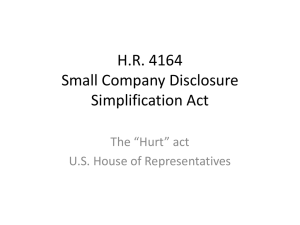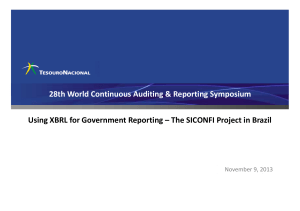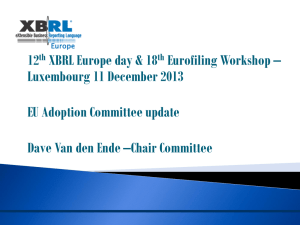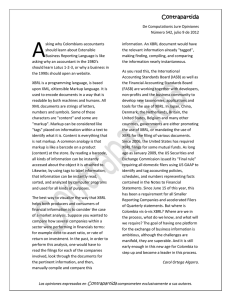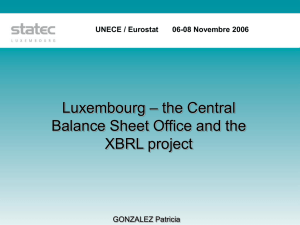Matherne - Transparency, Assurance, and Analysis
advertisement
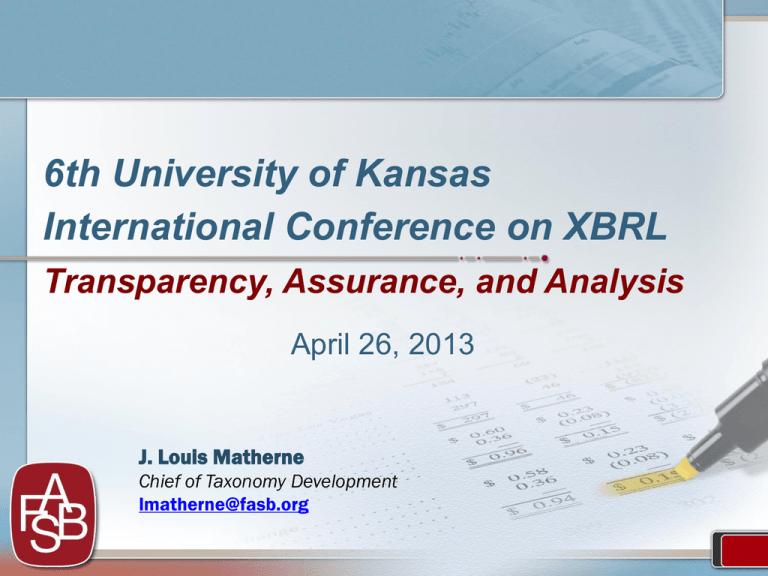
6th University of Kansas International Conference on XBRL Transparency, Assurance, and Analysis April 26, 2013 J. Louis Matherne Chief of Taxonomy Development lmatherne@fasb.org Topics Key Goals for 2013 FASB Financial Data Analysis ASU Integration Understanding User Requirements UGT Element Usage 2 Key Goals for 2013 Concurrent Taxonomy Exposure Drafts (TED) /Implementation Guides (IG) with Accounting Standards Updates Exposure Drafts Help drive improvements in data quality Promote a stable taxonomy XBRL Implementation Guides Increase input from data aggregators / users Establish banking / financial services industry group Support change management for all constituents 3 FASB Financial Data Analysis 4 FASB Data Requests FASB XBRL Team assists in obtaining financial statement data Disclosure topics where we have provided data: - Expected return of pension plan assets FVO disclosures Repurchase agreements Joint ventures of REITs Accounting changes and error corrections Business combinations Segments Unremitted foreign earnings Revenue recognition element use and label terminology 5 XBRL Data Example 3 – FASB Data Request Query: Identify trend in expected return on plan assets Can this be obtained through XBRL data? 6 XBRL Data Example 3 – FASB Data Request Key: Element Name 7 XBRL Data Example 3 – FASB Data Request Run query 8 XBRL Data Example 3 – FASB Data Request Results Exported to Excel 9 XBRL Data Example 3 – FASB Data Request Results - Table 2008 2009 2010 2011 2012 Average 7.74% 7.49% 7.34% 7.08% 7.23% Median 8.00% 8.00% 7.75% 7.50% 7.50% Mode 8.00% 8.00% 8.00% 8.00% 7.50% Max 12.30% 12.30% 15.00% 14.25% 9.20% Min 2.50% 1.40% 0.40% 0.24% 3.00% 379 1126 1309 1288 57 Count 10 ASU Integration 11 12 Financial Reporting Model Focus is on Principles (Principles) Accounting Standard Setters Logical (Business Requirements) Data Modelers Traditional print media Physical (Application) Focus is on Application Conceptual New digital media 13 Taxonomy Exposure Draft Process Accounting Standards Update (ASU) Exposure Process On FASB Agenda Deliberate Exposure Draft Ballot Deliberate Ballot Final Taxonomy Exposure Draft (TED) Process Watch Engage Model Disclosure Expose Taxonomy Fragment Revise Revise Final Steps • Create example disclosure with ASU Project Team • Create elements & modeling • Create instance document • Expose TED concurrent with ASU ED • Revise based on public feedback and Board deliberations • Release in base taxonomy as complete 14 Accounting Standards Updates XBRL team member assigned to project team based on topic area Participation/presence at Board discussions Links on website between exposure documents and XBRL ASU Taxonomy change page Benefits of earlier integration in the process Inform standard setting process Conceptually align approach Consider implications of data model Assist with research 15 Recent Projects Reclassifications from AOCI - Discussions with project team influenced modeling - users wanted effect of reclassification adjustments on Income Statement line items - XBRL Team prepared memo to Board on impact to UGT of presentation considerations - Participated in Board meeting to discuss memo - Follow up with Board member individually for further discussion - Resulted in ASU containing XBRL team recommendation (parenthetical requirement) Repurchase Agreements - Discussions with project team on differences in definition of repurchase agreements between ASUs (Balance Sheet Offsetting and Repurchase Agreements) - Identified need for additional element to reconcile 16 Recent Projects Revenue Recognition - Discussions with project team regarding impact to UGT of changes to presentation and disclosure requirements from original ED - Identified area in which XBRL data could assist project team with research - Clarified intent regarding contract assets/liabilities resulting in potential less impact to UGT Discontinued Operations - Discussions with project team on appearance of redundancy in disclosure requirements, inconsistency in implementation guidance and reversion of definition - Result is clarification of disclosure, removal of inconsistencies in exposure draft and update of NTS for change in definition 17 Review of ASU Impact to UGT – XBRL Team Most current draft available/listen to Board discussions - Important to understand underlying accounting & user expectations - Scope changes impact - Focus on presentation / disclosure areas and implementation guidance section Identify areas of UGT that will be impacted - Flat file useful for filtering (references, element search) Amendment section of ASU Identify disclosure sections of UGT impacted Consider impact to other areas (cash flow, disclosure overlap) 18 Review of ASU Impact to UGT – XBRL Team Assess impact - New elements Deprecations Definition changes (conform to style guide) Calculation relationship changes (additions, deletions) Reference changes (additions, deletions) Structure appropriateness - Dimension/Line item approach Balance type - Income or cash flow perspective Period type – consider context guide Item type – consider EFM, SEC Staff Interpretations Question E.21, unit registry - Conform to XBRL Style Guide 19 Review of ASU Impact to UGT – XBRL Team Discussion with project team - Prepare targeted questions to clarify open items If extensive may be helpful to show specific section of ASU compared to section of UGT Expectations of line items for general requirements Which amounts expected to agree to face financials Expectation of further breakdowns of values Impact to other areas of Codification/UGT Discussion with TAG Modeling considerations 20 Meeting Data Provider Requirements 21 What we know so far about data provider expectations • • • • • • • Data quality and assurance Extensions are a concern but can be manageable Tagged earnings release Greater coverage of the 10K and 10Q Reported fact value relationships matter Much analysis is performed based on topic How to identify changes from filing to filing and taxonomy to taxonomy • Prefer tabular information over narrative • Expressed concern that service providers are providing conflicting guidance • Looking forward to inline XBRL 22 FASB – Addressing data provider requirements • Revised, streamlined, and stable calculation hierarchy • Stabilize taxonomy but XBRL taxonomy and instances will continue to change Need to focus on better change management from a data provider perspective 23 UGT Element Usage 24 UGT Element Usage 2012 10-Ks “Rough” Estimate 25 UGT Element Usage 2012 10-Ks “Rough” Estimate 26 27 28 29 30 31 UGT Element Usage Assume All Used Equally Normalized? 32 UGT Element Usage Target? 33 UGT Element Usage – Ideal? UGT Element Usage Target? 34 Questions ? 35 Bonus Slides 36 Data Modeling in the Standard Setting Process 37 Modeling ASU Presentation and Disclosure Requirements Shift from modeling based on: - Paper-based financial reports presentations - COD/ASU descriptions and related implementation presentations Shift modeling to: - Consideration of underlying relationships among fact values - Contemplation of data consumption 38 Questions we need to ask 1. WHAT is the underlying relationships of reported fact values based on common or unique disclosure structures? 2. WHAT is the best way to capture the underlying relationship - through a calculation or dimensional model? 3. WHAT is the most effective way to provide the information to data consumers? 39 The General Principles Behind Our “Data Modeling” Approach General Principles: Recognize Primary Domain - Primary Line Items For example, Balance Sheet items, or “Revenue” etc. Identify Secondary Attributes or Disaggregation – Dimension Each disclosure is a further description of face statement fact value attributes 40 Connect Financial Reports Analysis with Data Modeling Other Considerations: Same Facts Should be Modeled in the Same Way Users’ Perspective/Business Objective - Example Reclassification from AOCI ASU The Board received requests from financial statement users looking for the effect of reclassification adjustments on INCOME STATEMENT LINE ITEMS; AOCI and reclassification components are two fact value attributes of the primary domain and are modeled as dimensions. 41 7 “What” Questions We Should Ask During the Data Modeling Process WHAT statutory requirements does the model need to capture? WHAT common practice requirements does the model need to capture based on traditional paper-based financial reports? * WHAT is the underlying relationships of reported fact values based on common or unique disclosure structures? WHAT is the best way to capture the underlying relationship - through a calculation or dimensional model? WHAT is the most effective way to provide data users the information? WHAT is the common, flexible data model - “the template”? WHAT taxonomy structural requirements (EFM, style guide, etc.) does the template need to meet? * Subject to circumstance where no actual financial reports available 42 Line Item Modeling Approach Generally acceptable for items that are understood as primary, (i.e., revenue, cost of goods sold, etc.) Comparability more affected by line item extensions WHAT is the best way to capture the underlying relationship? Dimension Modeling Approach Effective way to model the disaggregation or attribute identification of a primary concept Comparability less affected by member extensions 43 All fact value attributes will be contained within the line item as one concept. Calculation Relationship WHAT is the most effective way to provide data users the information? All of the line items available would have to be known that relate to this information and then searched for within the data to see if it exists. Allows the data to be “sliced and diced” as needed by the users of the information. Dimensional Relationship Depending on what the users of the information are looking for, they can extract the attributes that are important to them. 44 Organize the Disclosures in the “Template” 45 Data Model Scorecard® A tool that helps us evaluate the “template” post data modeling process. # Question 1 How well do the characteristics of the model support the type of model? 10 2 How well does the model capture the requirements? 15 3 How complete is the model? 15 4 How structurally sound is the model? 15 5 How well does the model leverage generic structures? 10 6 How well does the model follow naming standards? 5 7 How well has the model been arranged for readability? 5 8 How good are the definitions? 10 9 How consistent is the model with the enterprise? 5 10 How well does the metadata match the data? TOTAL SCORE Steve Hoberman & Associates, LLC Score Model Score % Comments 10 100 www.stevehoberman.com 46 Example – Other Comprehensive Income 47 Disclosing Reclassifications Out of AOCI on the Face Statements How do you distinguish expense amounts before and after the effect of reclassifications out of OCI? How do you distinguish gain on sale of securities amounts before and after the effect of reclassifications out of OCI? What if there is more than reclassification adjustment? 48 Using “Line Item” Approach 49 Using “Dimension” Approach 50 OCI - Template Entity XYZ Notes to Financial Statements Reclassifications out of Accumulated Other Comprehensive Income (a) For the Period Ended December 31, 201X Reclassification from Accumulated Other Comprehensive Income [Axis] Reclassification from Accumulated Other Comprehensive Income [Member] Equity Components [Axis] New Axis New Member Accumulated Net Gain (Loss) from Designated or Qualifying Cash Flow Hedges [Member] Accumulated Net Unrealized Investment Gain (Loss) [Member] Accumulated Defined Benefit Plans Adjustment [Member] Derivative Instrument Risk [Axis] Interest Rate Contract [Member] Gains and losses on cash flow hedges Interest and Dividend Income, Operating Interest Expense, Other Revenues Cost of Goods Sold Credit Risk Contract [Member] Foreign Exchange Contract [Member] Commodity Contract [Member] 1,000 (500) 2,500 (2,000) Unrealized gains and losses on available-for-sale securities Available-for-sale Securities, Gross Realized Gain (Loss), Excluding Other than Temporary Impairments Other than Temporary Impairment Losses, Investments, Portion Recognized in Earnings, Net Interest Expense, Other 2,300 (285) (15) Amortization of defined benefit pension items OCI, Reclassification, Pension and Other Postretirement Benefit Plans, Net Gain (Loss) Recognized in Net Periodic Benefit Cost, before Tax OCI, Reclassification, Pension and Other Postretirement Benefit Plans, Net Transition Asset (Obligation), Recognized in Net Periodic Benefit Cost, before Tax OCI, Amortization, Pension and Other Postretirement Benefit Plans, Net Prior Service Cost (Credit) Recognized in Net Periodic Benefit Cost, before Tax (2,000) (2,500) (1,500) Income (Loss), Including Portion Attributable to Noncontrolling Interest Income Tax Expense (Benefit), Continuing Operations, Discontinued Operations, Extraordinary Items Net Income (Loss), Including Portion Attributable to Noncontrolling Interest 1,000 (250) 750 2,000 (500) 1,500 (6,000) 1,500 (4,500) (2,250) 51 Example - Revenue Recognition 52 Revenue Recognition – Exposure Draft Disaggregation of Revenue 605-10-50-6 An entity shall disaggregate revenue from contracts with customers (excluding amounts presented for customers’ credit risk) into the primary categories that depict how the nature, amount, timing, and uncertainty of revenue and cash flows are affected by economic factors. To meet the disclosure objective in paragraph 605-10-50-1, an entity may need to use more than one type of category to disaggregate revenue. 53 Revenue Recognition – Exposure Draft 605-10-50-7 Examples of categories that might be appropriate include all of the following: - a. Type of good or service (for example, major product lines) - b. Geography (for example, country or region) - c. Market or type of customer (for example, government and nongovernment customers) - d. Type of contract (for example, fixed-price and time-and-materials contracts) - e. Contract duration (for example, short-term and long-term contracts) - f. Timing of transfer of goods or services (for example, revenue from goods or services transferred to customers at a point in time and revenue from - g. Sales channels (for example, goods sold directly to consumers and goods sold through intermediaries). 54 Revenue Recognition - Template Preliminary Data Model of 605-10-50-7 55


